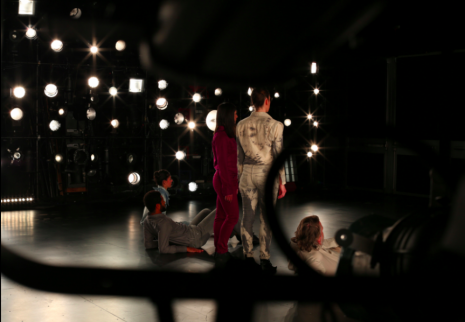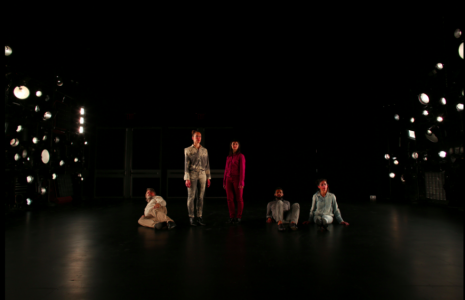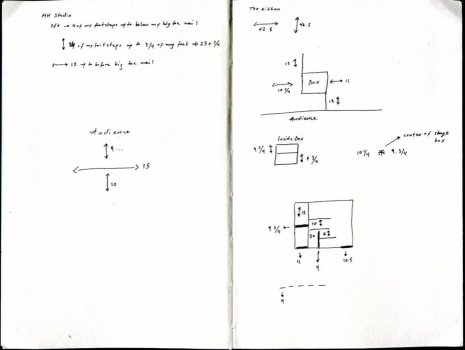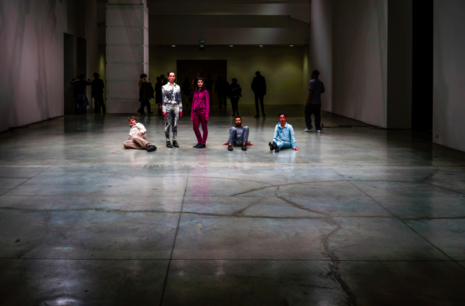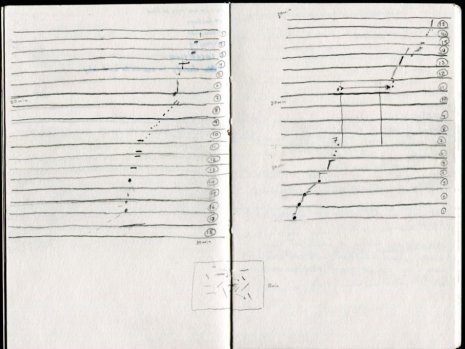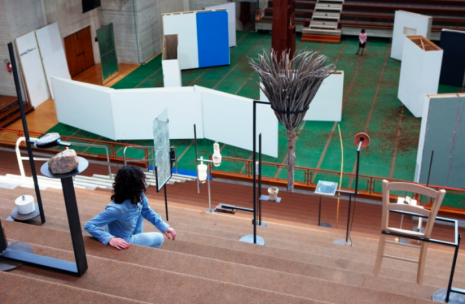Chapter One
What follows is the email conversation between Maria Hassabi and Victoria Marks, choreographer, professor, UCLA, World Arts and Cultures/Dance, Herb Alpert Award winner 1997, and 2015 panelist, March-April 2015. This has been edited.
- Irene Borger, Director
Dear Maria,
I look forward to this conversation with you, and am very eager to know more about you and your work. To begin, I’d like to share some of my reactions to your work, experiences that made me unable to stop thinking about your dances.
I could not help but to study my body as I attended to the performers’s. Ordinary actions became unfamiliar. The sense of a specialized moment of performance collided with "being in the company of" another person. As a spectator, I became aware of my gaze as intrinsically connected to the dance itself.
It seems to me you have had to both embrace performance and also reject many facets of “dancing.” Could you share what you are enchanted by (in dance, or art or performance), and what sends you howling in the other direction?
Vic
Dear Victoria,
Thank you for your kind words. I’m also happy to get the chance to have this discussion with you.
In general, I’m attracted to art that offers space; space to enter it, to experience it on one’s own terms. I’m not referring to “space” in a literal sense but rather in an abstract way.
I’m often turned off immediately by works that are asking for attention in obvious ways, which are full of themselves, and are didactic.
I’m attracted to conceptual clarity, formal awareness, a reflection back to the medium one is working with, and in general I’m drawn to art that dares to have a viewpoint and an ideology, whatever that may be.
Lately I find myself busy with trying to define the sensation of “temperature.” Also an abstract concept, but when I find a work impactful—both object-based and time-based works—I catch myself experiencing a physical sensation of warmth or cold that is beyond intellectuality. It is almost as if the works themselves produce a sense of temperature—heat, cold, a breeze.
Maria
VM:
Maria, what do you mean by “a reflection back to the medium one is working with?” Could you say more about that?
MH:
The medium I’ve been involved with for over 20 years is dance and live-performance, and there’s an evolution through history attached to it, fortunately. I would not be able to create my work without the precedent set by choreographers and artists who came before me. Even if I reject a lot of it, I’m still concerned with the most immediate elements of this medium: performer, audience, time, space. And yes, physicality definitely forms the center of my work. I’m completely occupied with the richness of physicality and how performers can carry it through.
VM:
Maria, you say your work is built upon precedents set by other choreographers and artists. In what ways are you part of a tradition of ideas and embodied practice? Who are some of the mentors you associate with that tradition, and in what ways are you innovating? Who are other innovators that you admire?
MH:
I consciously want to avoid discussing my influences. There are many people who I have admired and adored through the years, yet I do not want to touch on this subject. Lots of artists have influenced my work and being, and also non-artists. I’m happy I live in a time when information is easily accessible and shared. My influences keep changing depending on my own growth and the needs I have at any given moment—even depending on subjects I’m researching at times.
Through the years I have developed a distinct approach to art making. I used to be very curious in an external way, wanting to learn everything that was out there. For a while now, my curiosity has been much more internal and focused on my own exploration - the definition of my practice. This has allowed me to develop my way of working, one that is centered on the relation of the body to the image, defined by sculptural physicality, extended duration, and aesthetic precision.
VM:
I suspect readers would want to know more about what you mean, regarding “…the relationship of the body to the image as defined by sculptural physicality and extended duration,” but especially “aesthetic precision.” What is aesthetic precision?
MH:
When I began developing my practice, I was led by a deep desire to have more time to be with what was in front of me, what was put on display. Earlier on, my works were a reflection of the fast-paced life I was living. In 2006, I turned my focus to creating works that were not mirroring the reality I was living, but rather an ideal I was seeking; having the time to see and be. I began deconstructing my material by inserting pauses between actions and sustaining them. This is when I noticed a parade of representations that the body constantly creates in space. I found this beautiful, as it was both theatrical and everyday, a series of discernible images. Embodying images and uncovering how they could be supported in live performance became an objective of my work.
With our movements sustained over a long span of time, I began paying attention to what the body produced through its physicality. The body has weight, it creates noise, has muscular strain, tension, it releases, deteriorates through time, it breathes. These became the essential fragments of physicality that enriched my choreographic language. Next, I pared down my material, keeping only the indispensable.
The material that came from this process, along with the specificity required by the performer to execute it, are some of the ways that aesthetic precision comes into my work. I have the need to understand my work as an edited text rather than an improvised way of speaking: for each physical gesture to be exact, with an awareness of what it can represent in each moment.
Even though my initial intention was to create images, the images I produce are constantly broken. For example, let’s say if you pause a movie, you’re not seeing any action, not a breath. In live performance it might seem paused, but it never is. There’s always movement, there’s always a breath.
My work draws its strength from the tension between the human subject and the artistic object, the dancer as a performer and as a physical entity. Reducing movement over time, I use abstraction to develop a way of seeing the body as a fragmented form, and ultimately, as an affecting force.
VM:
How can the body be a “fragmented form?” Are we not always complete? How is this force affecting? When you speak about your work as "a practice in abstraction,” how do you mean that? Can the body ever be abstract? (Please forgive these questions, but language is so imprecise and I want to be sure I understand.)
MH:
With its slowness and gradual progression, my choreography enables “a waiting,” where form is captured and can be contemplated. As images shift, the relation between space, duration and movement is intensely magnified, and the viewer is given the chance to enter another realm of consciousness and awareness.
Preoccupied with velocity of deceleration, and the radical corporeality of the body and its elements, my works reveal the body at its most vulnerable, perhaps even in its most unnatural state. This foregrounds both the enormous demands made on the performers, and every last detail of the performing body. Often working close to the ground, the performers assume an uncanny sculptural quality as they negotiate the twists and turns of a plastic choreography. The human figure can seem palpable, material, and under pressure from gravity.
""I’m attracted to art that offers space; space to enter it, to experience it on one’s own terms.""



